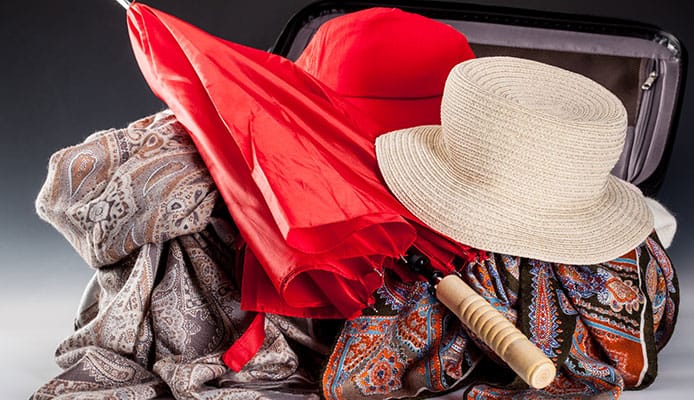
Weather can be very unpredictable, and a nice sunny day can turn into a downpour in a matter of minutes. Still, no one enjoys carrying a large non-folding umbrella on the off chance it starts raining. This is where a travel umbrella comes in – it’s compact, lightweight, and easy to take with you wherever you go.
Due to its folding nature, a travel umbrella packs very small when not in use. This is very handy, as it fits easily in your bag so you always have it when you need it. A top rated compact umbrella is not only easily portable, but also protects you from rain, wind, and even sun (if you want to). But how do you find the best one?
To do this, you have to look at the canopy size, construction quality, and ease of use among other things. The umbrellas we picked for our list are thoroughly tested and perform great in both heavy rain and strong winds. And, if you want to learn more about what makes a great folding umbrella, be sure to check out the buying guide too.
OUR TOP PICK
Repel Blue Sky
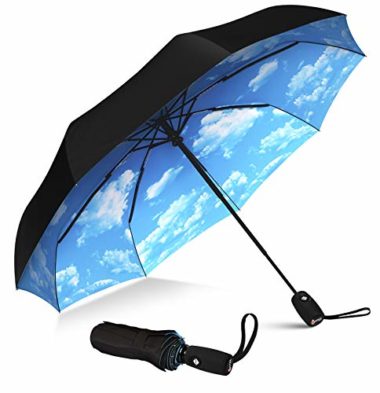
- Stand Out Features - Why We Love It
- Teflon-coated canopy for easily repelling water
- Nine reinforced ribs improve wind resistance
- Chrome coating makes the shaft rust-resistant
- Ergonomic non-slip rubber handle
- Comes in a protective travel sleeve
Type: Automatic
Arc: 42 inches
Height: 22.4 inches
Canopy material: Synthetic with Teflon coating
Frame material: Fiberglass ribs, chrome plated black metal shaft
Folded size: 11.5 inches
Weight: 14.4 ounces
EDITORS CHOICE
Repel Double Vented
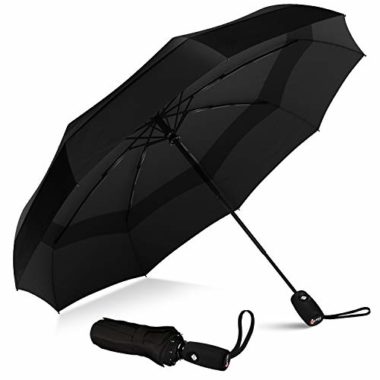
- Stand Out Features - Why We Love It
- Double-vented canopy resists strong wind
- Nine reinforced ribs prevent canopy flipping
- Teflon coating on the canopy easily fends off water
- Easy automatic one-button open/close system
- Lifetime replacement warranty included
Type: Automatic
Arc: 42 inches
Height: 21.5 inches
Canopy material: Synthetic with Teflon coating
Frame material: Fiberglass ribs, chrome plated black metal shaft
Folded size: 11.5 inches
Weight: 12 ounces
BEST VALUE
EEZ-Y Double Vented
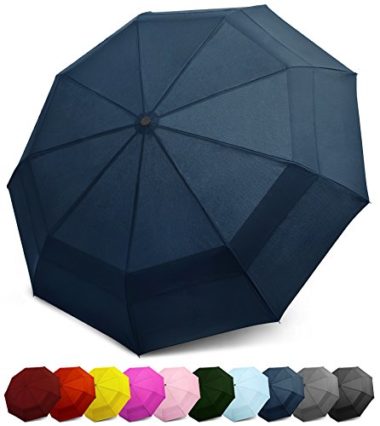
- Stand Out Features - Why We Love It
- Double canopy design prevents flipping
- Premium material quality for extended durability
- Rubberized handle comes with a safety leash
- Smooth and reliable automatic open/close system
- Large number of color options available
Type: Automatic
Arc: 42 inches
Diameter: 37 inches
Height: 22 inches
Canopy material: 210T fabric
Frame material: Fiberglass ribs, stainless steel shaft
Folded size: 11 inches
Weight: 0.9 pounds
YUI Galleria Compact
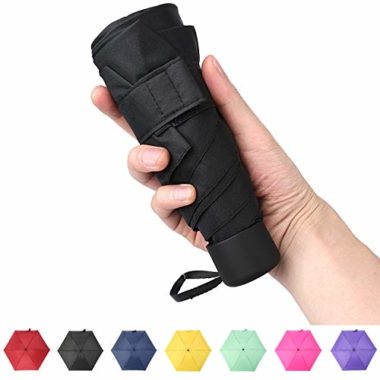
- Stand Out Features - Why We Love It
- Smaller and more compact than all others
- High-quality water-repellent polyester canopy
- UPF 50+ protects you from the sun too
- Comes in a convenient packing sleeve
- Lifetime replacement or refund warranty
Type: Manual
Diameter: 34 inches
Canopy material: 190T waterproof polyester
Frame material: Fiberglass ribs, steel shaft
Folded size: 6.7 inches
Weight: 6.7 ounces
Rain-Mate Compact
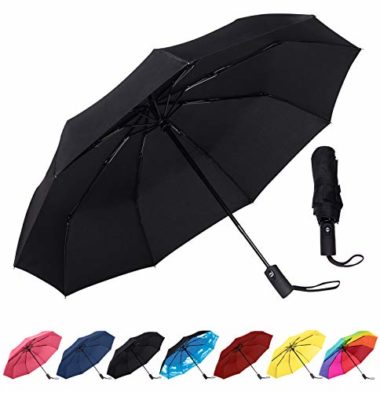
- Stand Out Features - Why We Love It
- Extra-tough metal frame with nine fiberglass ribs
- Fail-safe flip technology prevents damage from flipping
- Ergonomic rubber handle for easier carrying
- Three-piece collapsible shaft makes it compact and portable
- Lifetime replacement guarantee regardless of the issue
Type: Automatic
Arc: 42 inches
Canopy material: Waterproof synthetics
Frame material: Fiberglass ribs, metal shaft
Folded size: 12 inches
Weight: 14.4 ounces
LifeTek Windproof
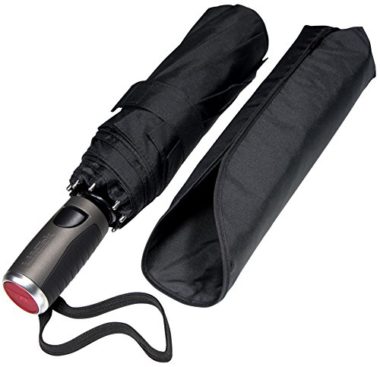
- Stand Out Features - Why We Love It
- Tri-fold ribs for more compact packing
- Handle leash prevents losing the umbrella
- Teflon coating easily repels water
- Canopy fabric provides UV protection too
- Four elegant color options
Type: Automatic
Arc: 42 inches
Height: 23 inches
Canopy material: Micro-weave 210T fabric with Teflon coating
Frame material: Reinforced fiberglass ribs, steel and aluminum frame
Folded size: 11.5 inches
Weight: 15 ounces
Bodyguard 10 Ribs
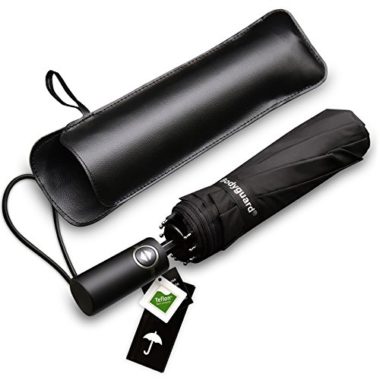
- Stand Out Features - Why We Love It
- Larger than all other travel umbrellas
- Ten ribs make the canopy incredibly stable
- Sturdy canopy material with Teflon coating
- Slip-proof handle with one-button operation
- Room to fit two or three people
Type: Automatic
Arc: 46.5 inches
Height: 25.2 inches
Canopy material: Synthetics with Teflon coating
Frame material: Reinforced resin ribs, metal frame
Folded size: 12.6 inches
Weight: 0.95 pounds
Lewis N. Clark Compact
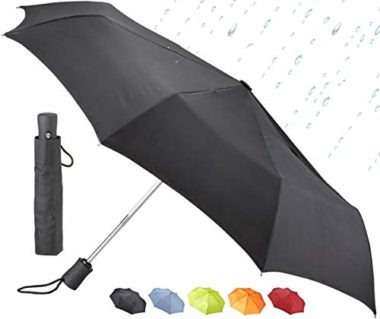
- Stand Out Features - Why We Love It
- Rust-resistant chrome-plated metal shaft
- Metal ribs easily withstand strong winds
- Turning doesn’t damage the construction
- Quick-drying canopy is resistant to mildew
- Great quality for the price
Type: Automatic
Arc: 38 inches
Height: 16 inches
Canopy material: Polyester
Frame material: Metal ribs, chrome-plated steel shaft
Folded size: 10.75 inches
Weight: 10 ounces
Vumos Mini
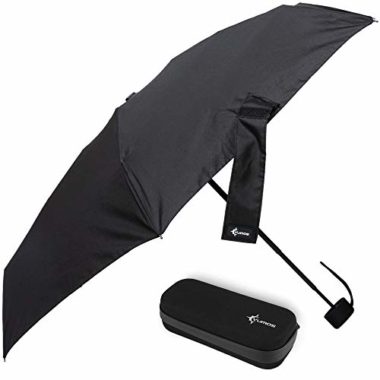
- Stand Out Features - Why We Love It
- Incredibly small and easy to pack
- Hardshell travel case included
- Pongee canopy treated with waterproof coating
- Unisex design with many great colors
- Comes with a full lifetime guarantee
Type: Manual
Diameter: 35 inches
Height: 25 inches
Canopy material: Pongee fabric
Frame material: Reinforced resin ribs, metal shaft
Folded size: 7.25 inches
Weight: 0.46 pounds
Actor StormProof
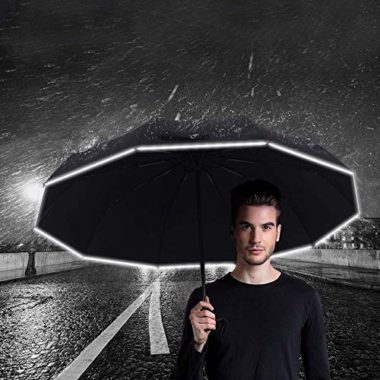
- Stand Out Features - Why We Love It
- StormProof rib design resists winds beyond 70mph
- Reflecting edges improve visibility at night
- Fabric doesn’t soak in water and dries quickly
- Larger canopy gives better coverage
- Ergonomic handle for easier carrying
Type: Automatic
Arc: 44.9 inches
Height: 23.6 inches
Canopy material: 190T Pongee
Frame material: Reinforced resin ribs, black coated metal shaft
Folded size: 11.4 inches
Weight: 13 ounces
How To Choose A Travel Umbrella — Buying Guide

Canopy Size
While it’s obvious that a larger canopy gives us more coverage and therefore better protection, going with the largest portable umbrella isn’t always the best choice. One of the important things about this type of umbrella is its compact size when packed, and an extra-large canopy means it might not fit in your bag the way you would like.
Most travel umbrellas have canopies that are around 37 inches in diameter and have an arc of around 42 inches. Even though this is significantly smaller than many non-folding models, it’s necessary so it can be packed to 10-12 inches in length. To give you more options, we have also featured both smaller and larger portable umbrellas, but keep in mind that a 40-inch canopy isn’t going to pack very small.
Umbrella Weight
Much like size, weight is very important in a small umbrella’s design. Since you’ll be carrying it with you all the time, the umbrella should be as light as possible (without compromising quality). Unlike the much heavier straight umbrellas, the best mini umbrellas usually weigh anywhere between 10 and 14 ounces.
For some travelers, lighter always means better. This is why you can find models like the Vumos or Yui Galleria mini umbrellas that weigh well under 8 ounces. Still, keep in that materials used to dictate the weight of your small umbrella, and that going with the lightest one might mean sacrificing durability in the long run.
Frame and Canopy Materials
The quality of materials used is very important on a small umbrella, on the account that it has lots of joints and the opening and closing mechanism is a bit more complicated. This is why we advise that you don’t compromise on materials, even if it means you have to pay a few extra bucks.
Frame: For the shaft, most travel umbrellas use some type of metal alloy. Aluminum is a good choice because it’s lightweight and corrosion-resistant (you can pack the umbrella when it’s wet). If you want added durability, it’s best to go with a steel shaft, but make sure it has a protective coating so it doesn’t rust.
When talking about the ribs (spokes), they need to be much more flexible than the shaft. This is why, instead of aluminum, a good option for the ribs is fiberglass. Since the ribs on portable umbrellas have at least two joints, adding some flexibility to the mix is desirable (especially in windy conditions).
Canopy: Synthetic fabrics are generally used to make the canopy, either nylon or polyester. In addition to these two, you’ll also come across PVC canopies on some models. It goes without saying that, regardless of the material, a canopy should be fully waterproof.
To help it repel water, many manufacturers apply a coating of Teflon (or something similar) on it. This is a huge bonus because, instead of soaking in, the water forms into beads and rolls. It also helps the umbrella dry faster and prevents mildew from forming.
Strength and Durability
Both strength and durability are closely related to the materials used to make the umbrella. An umbrella with a steel frame and a nylon canopy will be very strong but perhaps too heavy to carry. On the other hand, small travel umbrellas with reinforced fiberglass frames and polyester canopies have shown impressive strength in windy conditions, all while keeping the weight fairly low.
In relation to this, the best travel umbrellas can withstand being dropped, shoved, and opened and closed countless times. We really appreciate it when the manufacturer gives a generous warranty on their product, and some models we featured come with a lifetime warranty. This goes to show that they believe in the quality, and you can use the windproof umbrella worry-free knowing that you’re covered if anything happens.
Grip Design
The grip (handle) design impacts how comfortable your umbrella is to use. Even though we’re talking about small umbrellas here, they should still be pleasant to hold. An ergonomically shaped handle not only makes the umbrella more comfortable to carry but also gives you a firmer grip when the wind starts pulling on it.
Besides just the shape, it’s good when the grip is rubberized or covered with foam to prevent it from accidentally slipping away. A useful feature on the umbrella handle might be a wrist strap – it prevents you from dropping the umbrella or the wind from blowing it out of your hand.
You might also like: Underwater Camera Housings
Protection from Rain and Wind
The main task of any umbrella is protecting you from the weather. How good it will do its job depends on all the factors we discussed so far. To give you optimal rain protection, the canopy should be large in diameter and made from waterproof materials (polyester with Teflon for example).
As for wind protection, the best mini travel umbrella should have a strong but flexible frame (aluminum, fiberglass) that can withstand wind gusts without flipping or breaking.
Portability and Ease of Use
The idea behind all travel umbrellas was to create rain protection that is easy to bring with you. For this reason, the most efficient travel umbrella shouldn’t be very large. As we mentioned when discussing size, most models measure 10 to 12 inches when folded. Going with an umbrella longer than that might make it inconvenient and less portable.
On top of this, you should have an easy time opening and closing the umbrella once you take it out of your bag. In this regard, it’s best that you go with a model that has an automatic open and close system. It’s also an advantage if your windproof umbrella comes with a sleeve because you can pack a wet umbrella and put it back in the bag without getting the other stuff wet.
FAQs
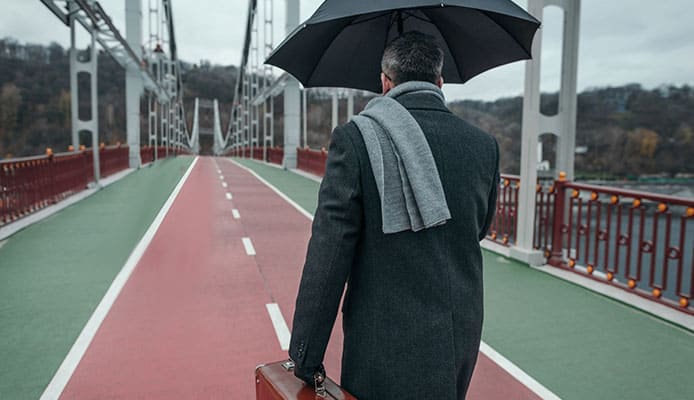
Q: Why bring a travel umbrella?
For quick and convenient rain protection. Unlike traditional straight umbrellas, travel umbrellas are very compact and easily fit in your bag, purse, or backpack. They don’t require much space or add too much weight to your bag, but they come in very handy when the weather takes a turn for the worse.
Q: What is an umbrella for traveling?
An umbrella for traveling is a compact umbrella that uses a foldable design. The canopy consists of foldable ribs, while the shaft has several telescopic pieces. This allows you to pack it very small and take it with you wherever you go. As a bonus, they are usually lighter than traditional umbrellas too.
Q: Can you take an umbrella on a plane?
Yes, most umbrellas are allowed on airplanes as carry-on luggage. All travel umbrellas are allowed to bring with you, as well as most traditional models up to 20 inches in length. However, if your umbrella is longer than 20 inches or has a pointy end, it's best to check with the airline whether they can go in the cabin or you need to put them in the checked-in luggage.
Q: How long should an umbrella last?
A high-quality umbrella can last up to five years (and some much more than that). However, this greatly depends on the construction quality of the umbrella you buy. As a bonus, some models (like Repel windproof travel umbrellas) offer a lifetime warranty with free replacements, so you can use the umbrella without worrying whether it will break.
Q: Is there a windproof umbrella?
While we can’t claim that any umbrella is truly windproof, many of the models we featured are highly wind-resistant. Thanks to the reinforced ribs, strong shafts, and high-quality canopies, some models can withstand winds up to 50mph without breaking. A double canopy also helps make the umbrella windproof, as it allows the air to circulate and prevents canopy flipping.
Q: Can an umbrella protect you from the sun?
Yes, it can. Research shows that an umbrella can block more than 75% of harmful UV rays on a bright sunny day. On top of this, the best umbrella color for sun protection is black which can block over 90% of UV rays. Additionally, black canopies give you the best shade, but also heat up much faster than other colors.
Globo Surf Overview
Regardless of where you’re going, a portable umbrella is great to have in your bag. You won’t even notice it most of the time, but it will keep you from getting soaked if rain surprises you. Top rated compact umbrellas are going to last very long and even come with an auto open and close feature for even easier use. Hopefully, our guide has helped you find the perfect model that will make sure you always stay dry.
More Watergear Water Protection Reviews:
- Waterproof Duct Tapes
- Waterproof Wallets
- Waterproof Phone Cases
- Waterproofing Sprays
- Waterproof Cast Covers
- Dry Bags
- Waterproof Duffel Bags

